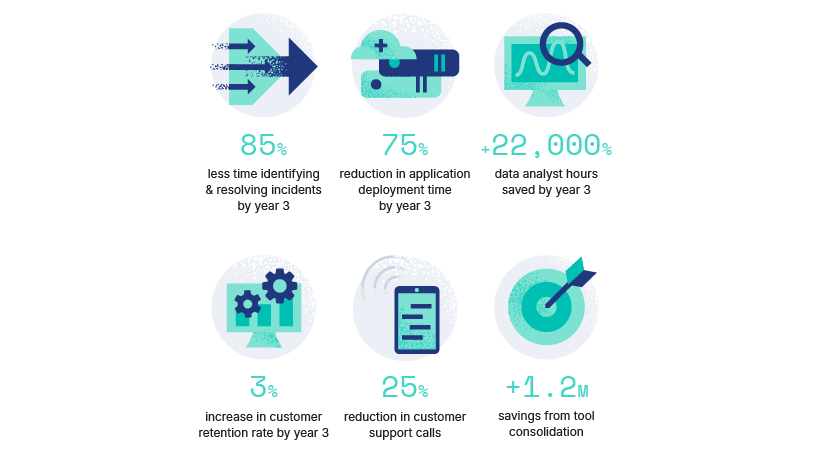Optimizes network performance
With Elastic AI and machine learning features, T-Mobile can predict and fix network issues before they have an impact on customers.
Simplifies development of use cases
With Elastic, T-Mobile can quickly build observability use cases without resorting to time-consuming software development.
Delivers better media search results
Customers can now search broadband TV media libraries and find content that matches their viewing tastes quickly with Elastic.

Dutch telecoms giant increases share of fixed broadband households using Elastic Observability to ensure network availability and market-leading download speeds.
When it comes to digital connectivity, few countries in Europe have a better track record than the Netherlands. Strong business demand for broadband and the largest proportion of remote workers in the EU1 means that 90% of the country is already served by fixed, high-capacity networks. Mobile coverage is equally remarkable with 5G mobile available in 97% of urban areas.2
In recent years, T-Mobile Netherlands has played a leading role in the expansion of these networks, with roughly seven million mobile and broadband customers across the country. This growth is driven by popularity with younger consumers and competitively priced broadband, TV, and mobile packages.3 Customer service is just as impressive. T-Mobile has been named 'excellent network' by Umlaut for the seventh time in a row.
"As connectivity increases so do the expectations of our customers," says Erwin Halmans, Project Manager, Data Driven Network Operations and Assurance, T-Mobile Netherlands. "Our challenge is to preserve and enhance our reputation through high-quality, uninterrupted services across the country."
To achieve this goal, T-Mobile must carefully monitor performance across its entire network. This includes several legacy networks and hundreds of thousands of endpoint devices, which generate terabytes of data every day. Data volumes are also set to increase with greater 5G coverage and the arrival of model driven telemetry (MDT), which provides near real-time access to data from networked devices.
Competing on service in a complex marketplace
Identifying and fixing errors in such a dense, complex environment put enormous pressure on the T-Mobile networking team. When the previous monitoring system alerted them to an error, they might spend hours or even days tracking down the source. Sometimes they only discovered that the network was underperforming when customers reported slow download speeds or a break in connectivity.
Getting the networking team on the front foot was a priority for Jan Stegink, Architect, Data Driven Network Operations and Assurance, T-Mobile Netherlands. "We wanted to reduce manual interventions and make data more accessible to users in the technology department. But to be more proactive we needed to rationalize and automate our network observability environment."
A flexible, fast observability solution
The T-Mobile IT department was already using Elastic on premises, so Stegink and Halmans undertook a proof of concept to see if it could be adapted to their goals. "It soon became apparent that Elastic Observability had the flexibility and speed to meet our objectives," says Stegink.
Today, T-Mobile’s observability deployment comprises telemetry data pipelines that feed into an on-premises data lake. This, in turn, feeds into Elastic Observability running on Elastic Cloud hosted by AWS. The new environment supports the development and delivery of analytical and artificial intelligence solutions for the Network Operations team, Network Planning, and Customer Operations.
"With Elastic Observability we can reduce or prevent network outages, enable faster root cause analysis, and deliver insights into network behavior. This significantly reduces network issues and helps increase customer satisfaction."
With the introduction of Elastic dynamic thresholds, T-Mobile has also boosted the accuracy of these alerts. Stegink says, "Static thresholds have the tendency to flag false positives that annoy network operators. At the other extreme they may be insensitive to genuine warnings that impact the customer. With Elastic we can set the right balance that keeps both internal and external audiences happy."
The deployment of Elastic Cloud also enables T-Mobile to scale at speed according to data volumes and processing demand. "The volume of data varies enormously, but Elastic Observability offers a highly flexible environment and we only pay for the capacity we need. It also means that we don’t have to support day-to-day management of the Elastic platform and can focus on activities that make a real difference to network performance," says Stegink.
Another important benefit of Elastic is that it enables network operations to develop and deliver analytical solutions more rapidly. "Building new use cases in Elastic is very straightforward. We’ve made several deployments in production, testing and development," says Stegink.
In addition to network observability, T-Mobile is using Elastic APM to monitor 50 operational applications. Elastic also powers search features that enable customers to search media catalogs and find content that matches their viewing tastes. "With Elastic, people can work better and faster. We expect to increase efficiency to the point where we minimize manual interventions in a zero-touch environment," says Halmans.

Explore the transformative impact of Elastic Observability in a recent Forrester study. Discover how you can improve business visibility and increase customer retention with a unified end-to-end observability solution
Partnership for a proactive future
Halmans stresses the role played by the team of Elastic consultants who supported the T-Mobile deployment. "The Elastic team listened carefully to our objectives and invested a lot of effort to understand the culture of the business. Their knowledge and experience helped us with new features and managing more complex technical elements," he says.
Above all, T-Mobile is confident that Elastic will support its mission to put customers first and deliver outstanding broadband services. This matters enormously in a highly competitive marketplace where residents in many urban areas can choose from multiple suppliers and 800,000 consumers change their internet service provider every year.4


